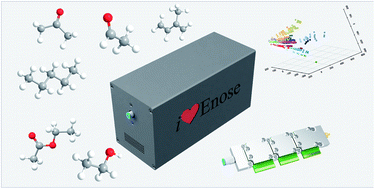An eNose-based method performing drift correction for online VOC detection under dry and humid conditions†
Abstract
Our recently demonstrated innovative concept of electronic nose (eNose) based on a combination of gas sensors is further tested and benchmarked in the present study. The system is a test bed for gas sensors of different principal technologies distributed within three compartments, which share a compact, very low volume, temperature-controlled sensing chamber. Here, the eNose-based analyser contains three sensing arrays of commercially available semiconducting metal oxide (MOX) gas sensors: one compartment contains 8 analog MOX sensors, while the other two compartments comprise 10 digital MOX sensors. The presented instrument is explicitly tested for the discrimination between mid-range (3–18 ppm) concentrations of different volatile organic compounds (VOCs) including acetaldehyde, acetone, ethanol, ethyl acetate, isoprene and n-pentane under dry and humid conditions, which are all considered relevant gases in future breath diagnostic applications. Since the experiments were performed in periods of time separated by around 20 days, they are affected by drift. For this reason, we explore the opportunity of drift mitigation using methods based on component removal computed by linear discriminant analysis, partial least squares discriminant analysis and direct orthogonalization, which lend themselves to future in-field applications of the developed device and sensing methodology.



 Please wait while we load your content...
Please wait while we load your content...